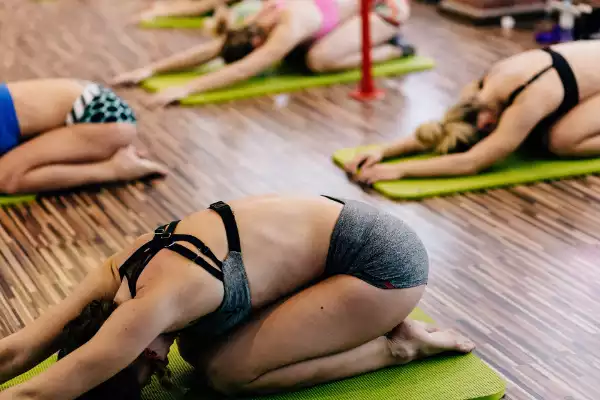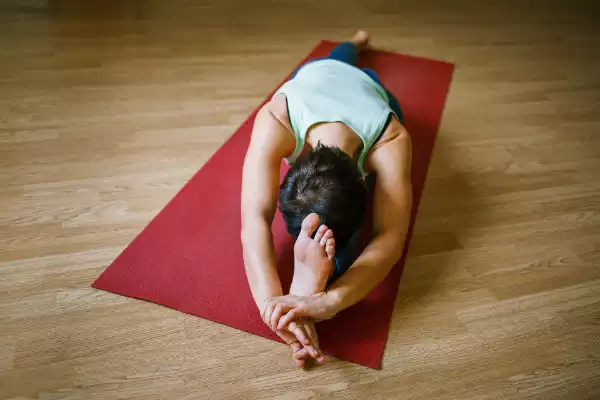Prepare for Hot Yoga
Are you considering taking on the challenge of hot yoga?
This popular form of yoga is practiced in a heated room, with temperatures ranging from 90-105 degrees Fahrenheit.
While it may seem intimidating at first, hot yoga has numerous benefits for both the mind and body.
These include increased flexibility, improved circulation, and detoxification through sweating.
However, before stepping into the heat, it is essential to properly prepare yourself for the intense practice.
In this article, we will guide you through the necessary steps to ensure you have a safe and enjoyable hot yoga experience.
From choosing the right clothing to staying hydrated, we will provide you with all the information you need to confidently enter the hot room.
Whether you are a beginner or a seasoned yogi, these tips will help you get the most out of your hot yoga practice.
So, let’s dive in and learn how to Prepare for Hot Yoga like a pro.
Table of Contents Prepare for Hot Yoga
Hydrate before and during class
To ensure a safe and effective hot yoga session, it is crucial to prioritize proper hydration before and during class.
Hot yoga induces profuse sweating, which can lead to dehydration if adequate fluids are not consumed.
Begin hydrating well in advance of your hot yoga class by drinking water throughout the day.
Aim to consume at least 16-20 ounces of water two to three hours before your session.
During class, make sure to bring a water bottle and take regular sips to replenish the fluids lost through sweat.
Maintaining optimal hydration levels will help regulate your body temperature, prevent muscle cramps, and support overall performance during your hot yoga practice.
Remember, staying hydrated is key to getting the most out of your hot yoga experience and avoiding any potential health risks.
So, be proactive and prioritize hydration as part of your preparation for hot yoga.
Wear light, breathable clothing
When preparing for hot yoga, it is essential to choose the right attire that promotes comfort and flexibility.
Opt for light, breathable clothing that allows your skin to breathe and helps regulate body temperature during the intense heat of the practice.
Look for materials such as moisture-wicking fabrics that can effectively absorb and evaporate sweat, keeping you cool and dry throughout the session.
Avoid heavy, restrictive clothing that may hinder your movements and cause discomfort.
Loose-fitting shorts, tank tops, or moisture-wicking leggings are great options to consider.
By wearing light and breathable clothing, you can enhance your overall experience and focus on your poses without feeling weighed down or overheated.
Remember, comfort and flexibility are key when it comes to selecting the proper attire for hot yoga.
Bring a towel and mat
To fully prepare for hot yoga, it is crucial to bring a towel and mat with you to the session.
The intense heat and humidity of the room can cause excessive sweating, making it necessary to have a towel to wipe away the moisture and maintain a secure grip during poses.
Look for a towel specifically designed for hot yoga, as these are often made from absorbent and quick-drying materials.
Placing a towel on your mat can also provide extra traction and prevent slipping, ensuring stability and safety throughout your practice.
Additionally, a mat is essential for creating a comfortable and hygienic space for your yoga practice.
Choose a mat that offers sufficient cushioning and grip, allowing you to move freely and confidently during the class.
By bringing a towel and mat, you can enhance your performance, prevent injuries, and fully immerse yourself in the invigorating experience of hot yoga.
Eat light, nutritious meals beforehand
To optimize your performance and maximize the benefits of hot yoga, it is important to fuel your body with light, nutritious meals beforehand.
This will provide you with the necessary energy and prevent any discomfort or digestive issues during your practice.
Opt for easily digestible foods that are rich in carbohydrates and protein, such as a fruit smoothie with Greek yogurt or a quinoa salad with vegetables and lean protein.
These meals can provide sustained energy without weighing you down, allowing you to move freely and comfortably during the class.
It is also advisable to eat at least two hours before your hot yoga session to give your body enough time to digest the food.
Remember to hydrate adequately before, during, and after the class to support your body’s performance and recovery.
By nourishing yourself with light, nutritious meals, you can optimize your hot yoga experience and achieve a greater sense of balance and well-being.
Avoid heavy or spicy foods
To further enhance your hot yoga experience, it is recommended to avoid consuming heavy or spicy foods prior to your session.
Heavy meals, such as those high in fats and large portions, can make you feel sluggish and uncomfortable during your practice.
Spicy foods, on the other hand, can lead to indigestion or heartburn, causing unnecessary discomfort while you are trying to focus on your movements and breath.
Instead, opt for lighter options that are easier to digest, such as fresh fruits, vegetables, and light proteins.
These choices will provide you with the necessary nutrients and energy without weighing you down.
By making mindful choices about your pre-yoga meals, you can ensure that your body feels light, energized, and ready to take on the challenges of hot yoga.
Arrive early to acclimate yourself
To fully prepare yourself for the intensity of hot yoga, it is essential to arrive early to acclimate yourself to the heated environment.
Arriving at the studio with enough time before your session allows your body to adjust to the elevated temperature, preventing any sudden shock to your system.
By giving yourself a few minutes to relax and settle in, you can gradually adapt to the heat and humidity, ensuring a more comfortable and effective practice.
Additionally, arriving early allows you to find a suitable spot in the room, set up your mat, and mentally prepare for the class ahead.
Use this time to take a few deep breaths, center yourself, and embrace the heat as a beneficial element of your hot yoga journey.
Listen to your body’s limits
During your hot yoga practice, it is crucial to listen to your body’s limits and honor its signals.
The heated environment can intensify the physical demands of the practice, making it essential to be mindful of how your body is feeling.
Pay attention to any sensations of discomfort, pain, or exhaustion.
If you experience any sharp or shooting pains, dizziness, or lightheadedness, it is important to take a step back and rest.
Pushing yourself beyond your limits can lead to injury or overexertion.
Remember, the purpose of hot yoga is to challenge yourself while maintaining a safe and sustainable practice.
If needed, modify poses or take breaks whenever necessary.
By respecting your body’s boundaries, you can enhance your hot yoga experience and progress at a pace that is suitable for you.
Don’t forget to breathe deeply
As you prepare for hot yoga, it is essential not to overlook the importance of deep breathing.
Deep, mindful breaths are a fundamental aspect of any yoga practice, and they become even more crucial in the heated environment of hot yoga.
By consciously focusing on your breath, you can enhance your body’s ability to regulate its temperature and maintain a sense of calm and control.
Deep breathing also helps to oxygenate your muscles, increasing their flexibility and reducing the risk of injury during your practice.
So, as you flow through the poses and sequences, remember to take slow, deliberate breaths, filling your lungs fully with each inhale and releasing tension with each exhale.
By incorporating deep breathing into your hot yoga practice, you can optimize the benefits and find greater harmony between your mind and body.
Congratulations, you are now equipped with the knowledge and tips to prepare for a hot yoga class! Remember to hydrate, dress appropriately, and listen to your body during the practice.
With these preparations in mind, you will be able to fully embrace the benefits of hot yoga and enjoy a challenging yet rewarding experience.
Don’t be afraid to try new poses and push yourself, but always stay mindful of your limits.
Namaste.
FAQ
What are the essential items or clothing I should bring to a hot yoga class?
When preparing for a hot yoga class, it’s important to bring a few essential items to ensure you have a comfortable and successful practice.
First, make sure to bring a non-slip yoga mat to help maintain stability during poses.
Additionally, wear lightweight and breathable clothing, such as moisture-wicking shorts or leggings and a tank top or sports bra.
Don’t forget to bring a towel to wipe away sweat and a water bottle to stay hydrated throughout the class.
Lastly, consider bringing a change of clothes for after the class to stay fresh and dry.
Are there any specific exercises or stretches I should do before attending a hot yoga session?
Before attending a hot yoga session, it is recommended that you incorporate exercises and stretches that help warm up your muscles and increase flexibility.
Start with dynamic movements like arm circles and leg swings to get your joints moving.
Then, focus on stretches that target the major muscle groups used in yoga, such as the hamstrings, hip flexors, and shoulders.
Incorporating exercises like lunges, squats, and downward dog can also help prepare your body for the heat and intensity of hot yoga.
Remember to listen to your body and modify any stretches or exercises based on your comfort level.
How should I hydrate and fuel my body before and after a hot yoga class?
To properly hydrate and fuel your body before and after a hot yoga class, you should focus on drinking plenty of water both before and after the session.
Before the class, make sure to drink at least 16 ounces of water to prepare your body for the heat and intense workout.
After the class, continue to hydrate by drinking more water and replenish electrolytes with a sports drink or coconut water.
Additionally, fuel your body by consuming a balanced meal or snack containing carbohydrates and protein within an hour after the class to aid in muscle recovery and replenish energy levels.
What are some tips for acclimating to the heat and humidity in a hot yoga studio?
To acclimate to the heat and humidity in a hot yoga studio, you should focus on staying hydrated by drinking plenty of water before, during, and after your practice.
Dress in light, breathable clothing and bring a towel to wipe away sweat.
Take breaks when needed and listen to your body’s limits.
Gradually increase your time and intensity in the studio to allow your body to adjust.
Remember to breathe deeply and stay present in the moment.
Embrace the heat as a tool for purification and relaxation.
Are there any precautions or considerations I should be aware of when practicing hot yoga, especially if I have certain health conditions or injuries?
When practicing hot yoga, it’s crucial for you to be mindful of any health conditions or injuries you may have.
First and foremost, it’s important to consult with your healthcare provider to ensure hot yoga is safe for you.
If you have cardiovascular issues, high blood pressure, or respiratory conditions, hot environments may exacerbate these conditions.
Additionally, if you have injuries, be cautious with certain poses and inform your instructor about your limitations.
Stay hydrated before, during, and after class, and listen to your body’s cues.
Taking breaks and modifying poses when needed is essential for your safety and well-being.




